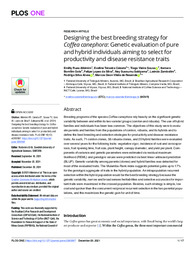Designing the best breeding strategy for Coffea canephora: Genetic evaluation of pure and hybrid individuals aiming to select for productivity and disease resistance traits.
Designing the best breeding strategy for Coffea canephora: Genetic evaluation of pure and hybrid individuals aiming to select for productivity and disease resistance traits.
Author(s): ALKIMIM, E. R.; CAIXETA, E. T.; SOUSA, T. V.; GOIS, I. B.; SILVA, F. L. da; SAKIYAMA, N. S.; ZAMBOLIM, L.; ALVES, R. S.; RESENDE, M. D. V. de
Summary: Breeding programs of the species Coffea canephora rely heavily on the significant genetic variability between and within its two varietal groups (conilon and robusta). The use of hybrid families and individuals has been less common. The objectives of this study were to evaluate parents and families from the populations of conilon, robusta, and its hybrids and to define the best breeding and selection strategies for productivity and disease resistance traits. As such, 71 conilon clones, 56 robusta clones, and 20 hybrid families were evaluated over several years for the following traits: vegetative vigor, incidence of rust and cercosporiosis, fruit ripening time, fruit size, plant height, canopy diameter, and yield per plant. Components of variance and genetic parameters were estimated via residual maximum likelihood (REML) and genotypic values were predicted via best linear unbiased prediction (BLUP). Genetic variability among parents (clones) and hybrid families was detected for most of the evaluated traits. The Mulamba-Rank index suggests potential gains up to 17% for the genotypic aggregate of traits in the hybrid population. An intrapopulation recurrent selection within the hybrid population would be the best breeding strategy because the genetic variability, narrow and broad senses heritabilities and selective accuracies for important traits were maximized in the crossed population. Besides, such strategy is simple, low cost and quicker than the concurrent reciprocal recurrent selection in the two parental populations, and this maximizes the genetic gain for unit of time.
Publication year: 2021
Types of publication: Journal article
Unit: Embrapa Coffee
Keywords: Café Robusta, Coffea, Melhoramento Genético Vegetal, Plant breeding
Observation
Some of Embrapa's publications are published as ePub files. To read them, use or download one of the following free software options to your computer or mobile device. Android: Google Play Books; IOS: iBooks; Windows and Linux: Calibre.
Access other publications
Access the Agricultural Research Database (BDPA) to consult Embrapa's full library collection and records.
Visit Embrapa Bookstore to purchase books and other publications sold by Embrapa.

